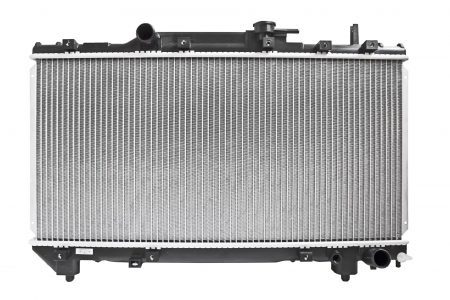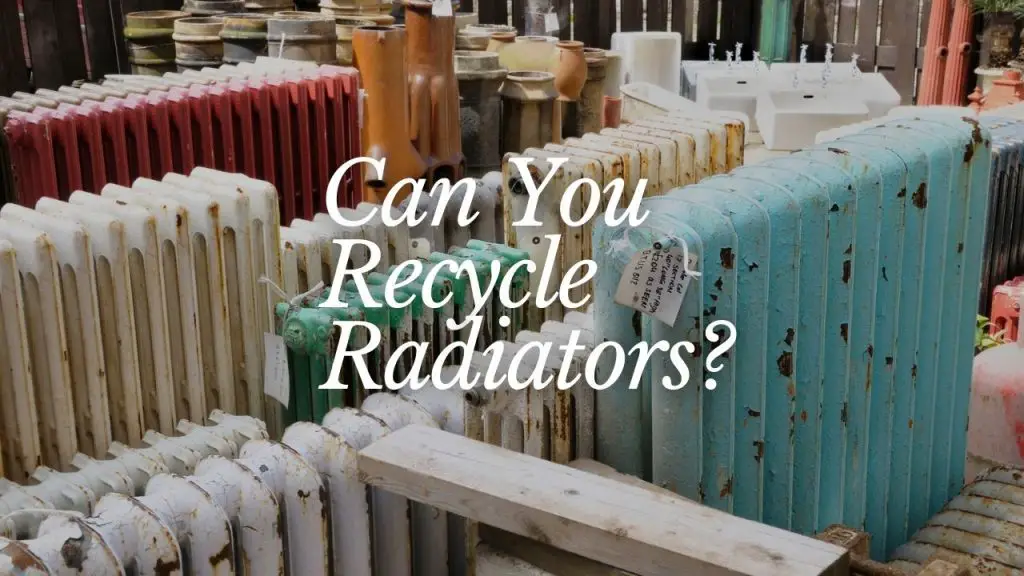As concerns about the impact of human activity on the environment continue to rise, it is increasingly important to prioritize eco-friendly practices in all aspects of life. Radiator recycling is no exception. If you have an old radiator that you no longer need, you can take several steps to dispose of it in an environmentally responsible manner.
One option is to donate your radiator to a scrap metal recycling facility. These facilities can safely dismantle and recycle the various metals that make up your radiators, such as copper and aluminum. Not only does this keep your radiator out of a landfill, but it also conserves natural resources and reduces the need for new metal production, a significant source of greenhouse gas emissions.
Another eco-friendly option is to sell your radiator to a repair shop or salvage yard. These businesses often have the resources and expertise to refurbish and reuse old radiators, which reduces the demand for new ones and helps to conserve resources.
Finally, suppose your radiator is beyond repair or reuse. You can still make an environmentally conscious decision by choosing a reputable recycling facility that follows all relevant regulations and best practices. This ensures that your radiator is safely and properly disposed of without harming the environment or workers’ health.
Recycling Radiators
Recycling radiators is a process that involves separating the various materials that make up a radiator, such as copper, aluminum, and brass, and processing them for reuse. Radiator recycling helps to conserve natural resources, reduce greenhouse gas emissions, and reduce the amount of waste in landfills. It is an important part of the larger effort to promote sustainable and environmentally friendly practices.
There are a few different ways to recycle radiators. One option is to donate your radiator to a scrap metal recycling facility, which will safely dismantle and recycle the various metals it contains. Another option is to sell your radiator to a repair shop or salvage yard, which may be able to refurbish and reuse it. If your radiator is beyond repair or reuse, you can choose a reputable recycling facility to dispose of it safely and by all relevant regulations.
If you want to recycle your radiator, it is important to research and choose a reputable facility or business to work with. This will ensure that your radiator is appropriately processed and recycled and that the environment is protected.
Does Autozone Take Old Radiators?
Autozone and many other auto parts stores will take used car parts like radiators and recycle them or sell them for scrap.

Where to Recycle Radiators
There are several options for recycling radiators, including scrap metal recycling facilities, repair shops, and salvage yards.
Scrap metal recycling facilities are specialized businesses equipped to dismantle and recycle many metal products, including radiators. These facilities typically accept radiators as long as they are free of contaminants, such as oil or coolant. To find a scrap metal recycling facility near you, you can search online directories or check with your local government for a list of licensed facilities in your area.
Repair shops and salvage yards may also be interested in purchasing used radiators for refurbishment and reuse. These businesses typically repair and sell used car parts, including radiators. You can search online directories or check with local companies to see if they are interested in buying your used radiator.
Can You Scrap Old House Radiators?
Old house radiators have a value of between 2 cents and 2 dollars a pound. A traditional cast iron radiator found in old homes should get you $10.50 at a junkyard. If the radiator has steel components, remove them, and you should be able to sell them for 5 cents a pound.
How to Prepare Your Radiator for Recycling
To prepare your radiator for recycling, you should follow these steps:
- Remove any contaminants: Before recycling your radiator, it is important to remove any contaminants, such as oil or coolant, that may be present. These substances can be harmful to the environment and to the workers who will be handling your radiator during the recycling process.
- Drain the radiator: To remove any remaining coolant or water, you will need to drain the radiator. This can usually be done by opening the drain valve or removing the drain plug at the bottom of the radiator.
- Remove any additional parts: If your radiator has other components, such as fans or mounting brackets, you should remove them before recycling the radiator. These parts may have value on their own and can be recycled separately.
- Clean the radiator: To make it easier for the recycling facility to process your radiator, you should try to remove as much dirt and debris as possible. You can use a hose or a pressure washer to wash off dirt or grime.
- Transport the radiator: Once it is clean and free of contaminants, you can transport it to the recycling facility. Follow local regulations or guidelines for transporting hazardous materials, such as used radiators.
By following these steps, you can ensure that your radiator is prepared for recycling in a safe and environmentally friendly way.
Are Old Car Radiators Worth Anything?
Old car radiators can be sold to scrap yards. The amount of money you’ll make depends on the materials they’re made of. Aluminum copper will get you $1.15 an lb; brass is $1.25 – $2 an lb, cast iron is 2 – 7 cents an lb, and steel will get you 5 cents an lb.
How Radiators Are Recycled
Radiators are recycled by separating the materials that make up the radiator, such as copper, aluminum, and brass, and processing them for reuse. The specific process for recycling radiators may vary depending on the facility, but it typically involves the following steps:
- Receiving and sorting: The first step in recycling is to receive the radiator and sort it into the appropriate category. This may involve separating radiators by size, type, or condition.
- Dismantling: Next, the radiator is dismantled to separate the various materials it is made of. This may involve removing additional parts, such as fans or mounting brackets and cutting the radiator into smaller pieces.
- Shredding: After the radiator has been dismantled, it is usually shredded into smaller pieces to make it easier to sort and separate the different materials.
- Separation: The shredded pieces of the radiator are then sorted according to their specific metal content using various techniques, such as air classification, hand sorting, and magnetic separation.
- Melting and refining: Once the different materials have been separated, they are melted down and refined to remove impurities. The resulting metal alloys can then be molded into new products or sold to other manufacturers for use in their products.
Can You Throw Radiators in the Regular Trash?
In general, throwing radiators in the regular trash is not recommended. Radiators contain hazardous materials, such as heavy metals, that can harm the environment if not correctly disposed of. Additionally, radiators are often made of valuable materials, such as copper and aluminum, that can be recycled and reused.
There are several options for properly disposing of radiators, including recycling facilities and scrap metal recycling facilities. These facilities are equipped to safely dismantle and recycle the materials that make up a radiator, such as copper, aluminum, and brass. By recycling your radiator, you can help conserve natural resources, reduce greenhouse gas emissions, and reduce the amount of waste in landfills.
In some cases, it may be possible to dispose of a radiator in the regular trash if it has properly drained all fluids and is free of contaminants. However, this will depend on the specific regulations in your area, and you should check with your local government or waste management provider for more information.
Generally, it is always best to recycle or properly dispose of radiators rather than throw them in the regular trash. This helps to protect the environment and the health of our communities.
What Happens When Radiators go to the Landfill?
When radiators are disposed of in a landfill, they take up valuable space and contribute to the overall volume of waste. Dumps are designed to contain and isolate waste but are not a permanent solution. Eventually, landfills reach capacity and must be closed, at which point the waste is covered and left to decompose over time.
Radiators contain hazardous materials, such as heavy metals, that can leach into the soil and water supply if not properly contained. These substances can negatively impact the environment and the health of humans and wildlife. Landfills are designed to contain and isolate these materials, but they are not foolproof, and there is always the risk of leakage or contamination.
In addition to the potential environmental impacts, landfills also contribute to greenhouse gas emissions. As waste decomposes in a landfill, it produces methane, a potent greenhouse gas significantly more harmful to the environment than carbon dioxide.
Overall, it is generally more environmentally responsible to recycle or properly dispose of radiators rather than sending them to a landfill. By recycling radiators, we can conserve natural resources, reduce greenhouse gas emissions, and reduce the amount of waste in landfills.
Conclusion
Recycling radiators is an important part of promoting sustainable and environmentally friendly practices. Radiators contain valuable materials, such as copper and aluminum, that can be recycled and reused, and recycling them helps to conserve natural resources and reduce greenhouse gas emissions.
There are several options for recycling radiators, including scrap metal recycling facilities, repair shops, and salvage yards. Choosing a reputable facility or business to work with is important to ensure that your radiator is properly processed and recycled and that the environment is protected. Throwing radiators in the regular trash or sending them to a landfill is generally not recommended, as it can negatively impact the environment and human health. By recycling your radiator, you can do your part to reduce waste and protect the planet.

